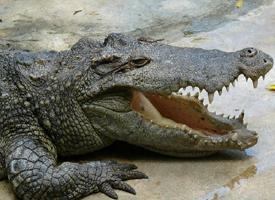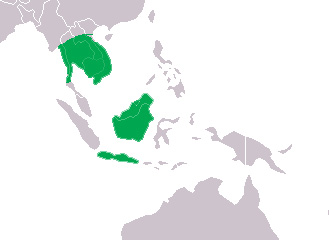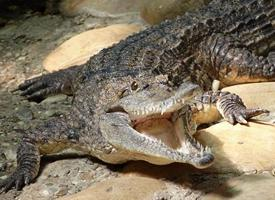
Poids et mesures
| Longueur | 3 m |
|---|
Statut de conservation
| Menacé |
Description de l'animal
The Siamese crocodile (Crocodylus siamensis) is a medium-sized freshwater crocodile native to Southeast Asia. With its populations distributed across parts of Indonesia, Brunei, East Malaysia, Laos, Cambodia, Burma, Thailand, and Vietnam, this species plays a significant role in the biodiversity of its habitat. Unfortunately, due to a variety of threats, it is considered critically endangered, making it one of the most threatened crocodile species in the world.Characteristically, the Siamese crocodile has a relatively moderate size compared to other members of the crocodilian family. Adults typically reach lengths of about 2.5 to 3 meters (8.2 to 9.8 feet), though there have been rare instances of individuals growing up to 4 meters (13 feet). The body is robust and covered in dark, olive-green scales, which provide camouflage within its murky freshwater habitat. Its belly, however, is a much lighter, almost creamy color. A distinctive feature of the Siamese crocodile is its relatively smooth skin compared to other crocodile species, with fewer bony plates (osteoderms) on its back. The snout is broad and short, equipped with strong jaws capable of a powerful grip, and the teeth are sharp and conical, designed for catching a variety of prey.
The diet of the Siamese crocodile primarily consists of fish, amphibians, and small mammals, although they are opportunistic feeders and will consume almost anything they can overpower. These crocodiles are known for their stealth and patience, often waiting motionless for hours for unsuspecting prey to come within striking distance.
Siamese crocodiles are typically found in slow-moving rivers, lakes, and swamps, with a preference for dense, vegetative cover. They are also known to inhabit man-made reservoirs and canals, adapting to a variety of freshwater environments. Despite their fierce appearance, they are generally shy and avoid human contact, making them less of a threat to humans compared to other crocodilian species.
Reproduction in Siamese crocodiles involves nest-building, where the female constructs a mound of vegetation and soil near the water's edge. Into this nest, she lays a clutch of 20 to 50 eggs, which she then guards diligently until they hatch. The incubation period lasts around 80 days, with the temperature of the nest determining the sex of the offspring. Once the young crocodiles hatch, they are cared for by both parents, a rare behavior among crocodiles, which helps increase their chances of survival in the wild.
The Siamese crocodile faces numerous threats that have led to its critical endangerment. Habitat destruction, due to agricultural expansion, dam construction, and logging, has significantly reduced its living space. Additionally, the species has suffered from overhunting and poaching, with individuals being killed for their skin, meat, and for use in traditional medicine. Efforts are being made
Carte de répartition

Animaux similaires
Nouvelles photos d'animaux
Top 10 des animaux
- Dolphin gull (Leucophaeus scoresbii)
- Diana monkey (Cercopithecus diana)
- Moustached guenon (Cercopithecus cephus)
- Galápagos tortoise (Geochelone nigra complex)
- Japanese macaque (Macaca fuscata)
- Russian tortoise (Testudo horsfieldii)
- Stone loach (Barbatula barbatula)
- Greek tortoise (Testudo graeca)
- Common flying dragon (Draco volans)
- Vendace (Coregonus albula)


